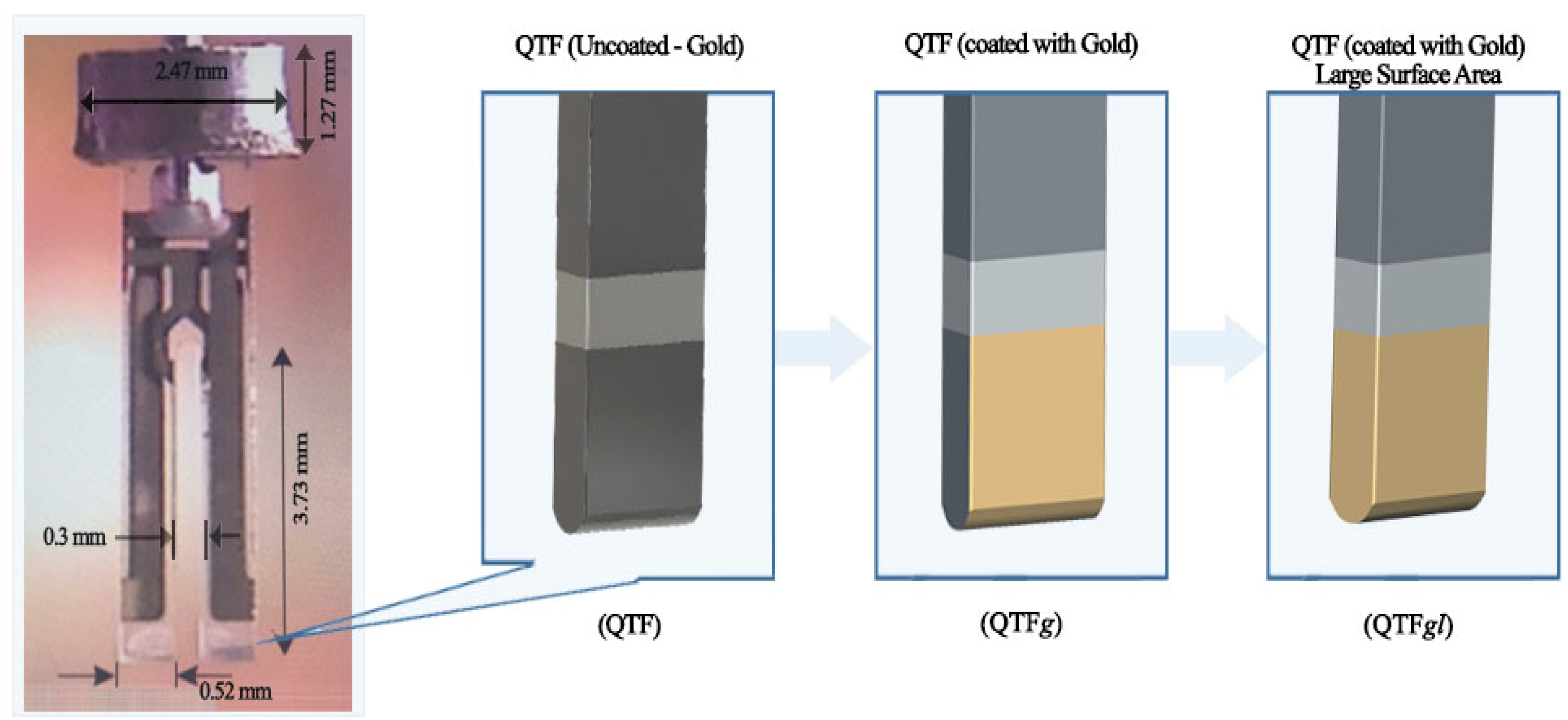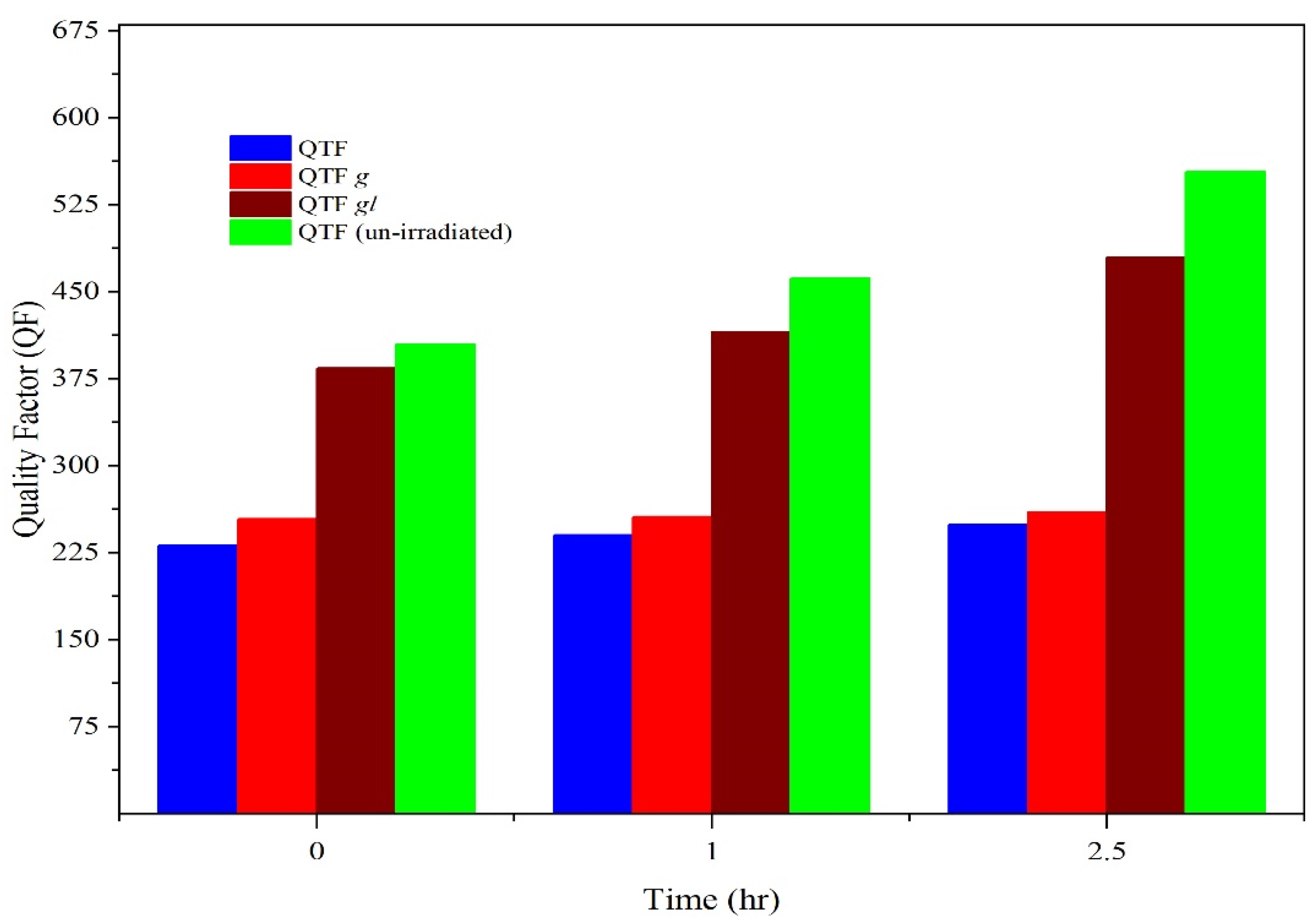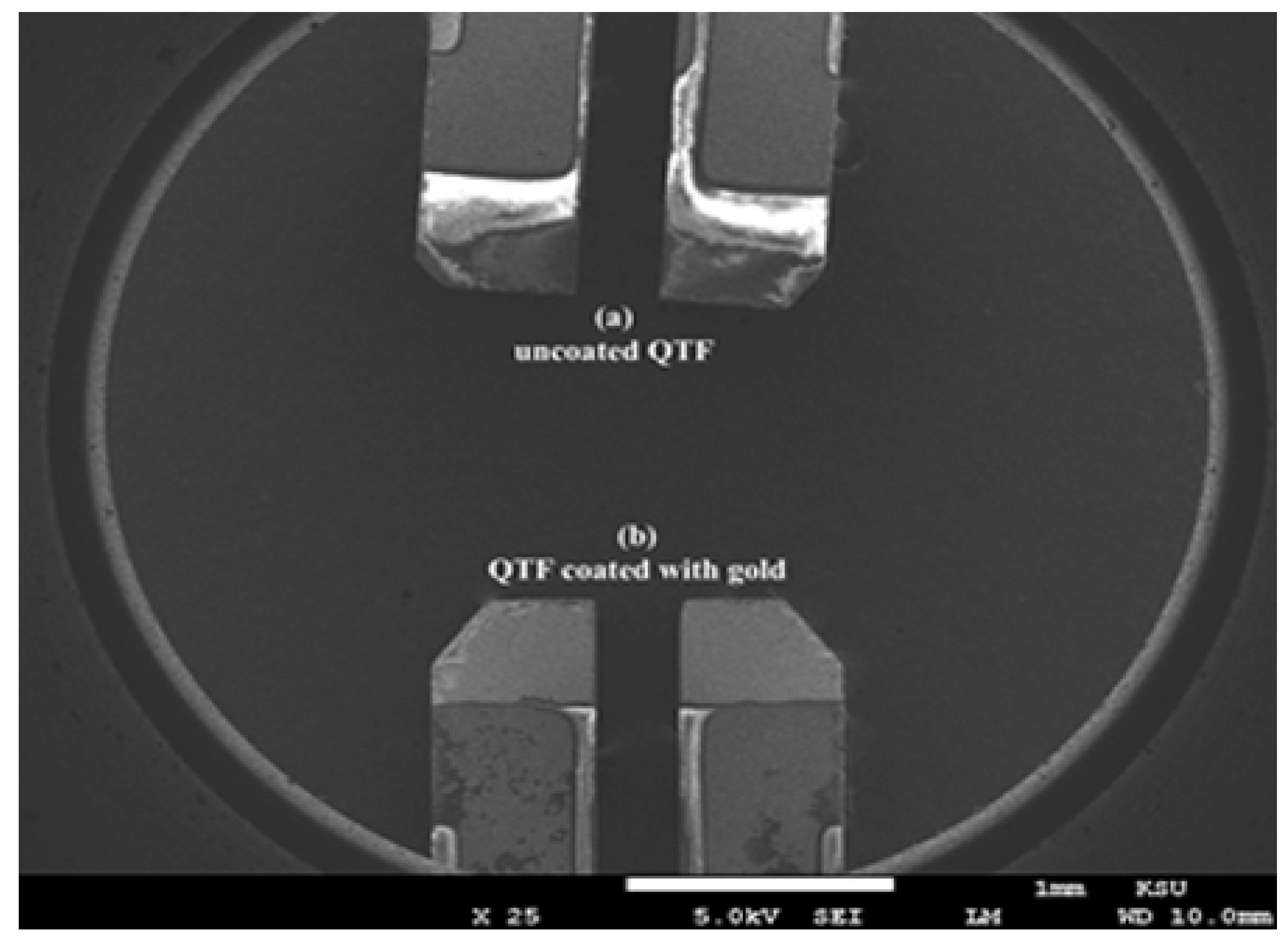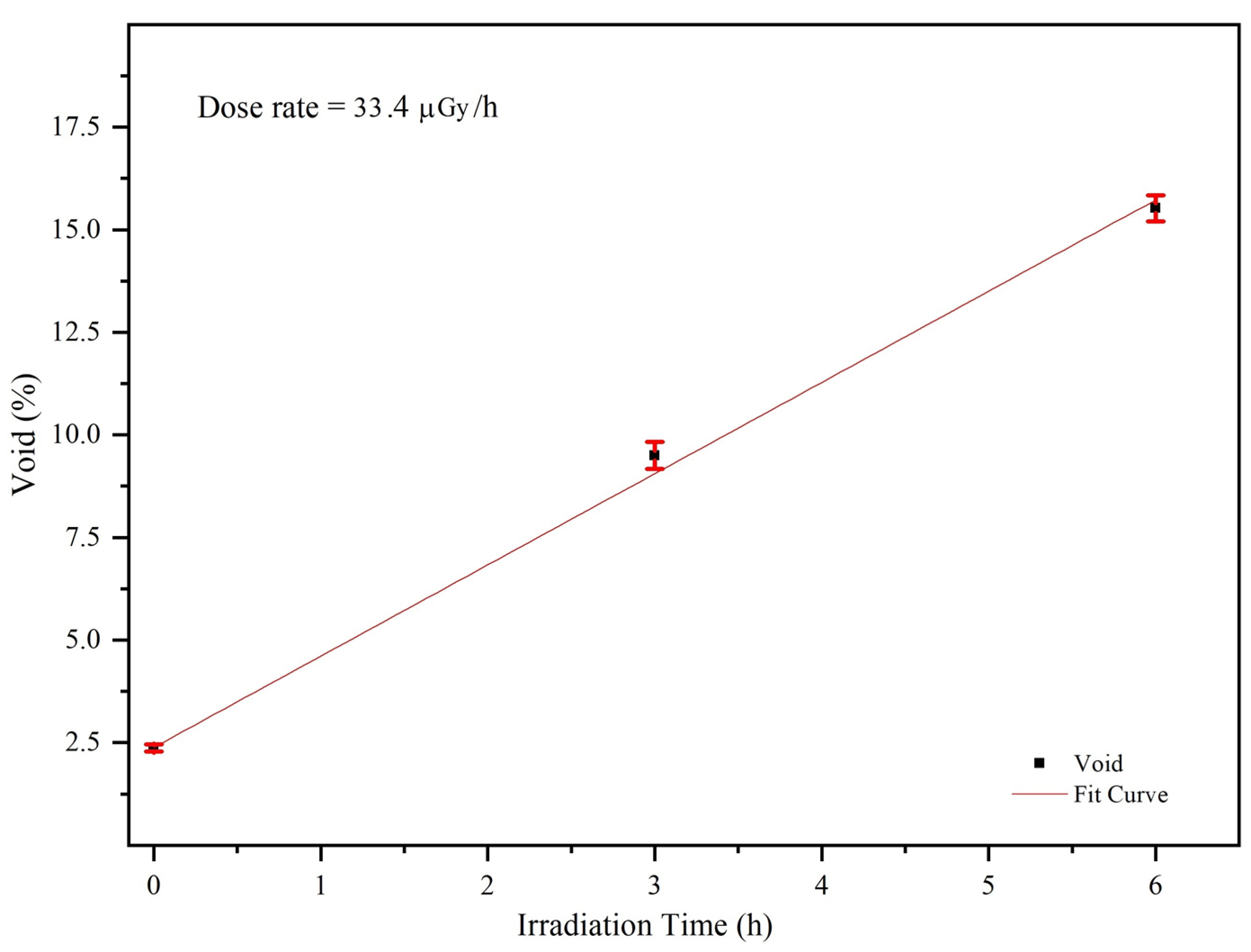Quartz Tuning Fork Sensor-Based Dosimetry for Sensitive Detection of Gamma Radiation
Abstract
1. Introduction
2. Experimental Details
3. Results and Discussion
4. Conclusions
Supplementary Materials
Author Contributions
Funding
Institutional Review Board Statement
Informed Consent Statement
Data Availability Statement
Conflicts of Interest
References
- Chmielewski, A.G.; Haji-Saeid, M. Radiation technologies: Past, present and future. Radiat. Phys. Chem. 2004, 71, 17–21. [Google Scholar] [CrossRef]
- Murray, R.L.; Holbert, K.E. An introduction to the concepts, systems, and applications of nuclear processes. In Nuclear Energy, 7th ed.; Elsevier Inc.: Boston, MA, USA, 2014; p. 1. [Google Scholar]
- Vaiserman, A.; Koliada, A.; Zabuga, O.; Socol, Y. Health Impacts of Low-Dose Ionizing Radiation: Current Scientific Debates and Regulatory Issues. Dose-Response 2018, 16, 1559325818796331. [Google Scholar] [CrossRef]
- Prasad, K.N.; Cole, W.C.; Haase, G.M. Radiation protection in humans: Extending the concept of as low as reasonably achievable (ALARA) from dose to biological damage. Br. J. Radiol. 2004, 77, 97–99. [Google Scholar] [CrossRef]
- Nicholas, T. Measurement and Detection of Radiation, 3rd ed.; CRC Press: Boca Raton, FL, USA, 2010. [Google Scholar]
- Hine, G.J.; Brownell, G.L. Radiation dosimetry. In Radiation Dosimetry; Academic Press: Cambridge, MA, USA, 2013. [Google Scholar]
- Pohlkötter, A.; Willer, U.; Bauer, C.; Schade, W. Resonant tuning fork detector for electromagnetic radiation. Appl. Opt. 2008, 48, B119–B125. [Google Scholar] [CrossRef] [PubMed]
- Ovsik, M.; Manas, M.; Stanek, M.; Dockal, A.; Mizera, A.; Fluxa, P.; Bednarik, M.; Adamek, M. Nano-Mechanical Properties of Surface Layers of Polyethylene Modified by Irradiation. Materials 2020, 13, 929. [Google Scholar] [CrossRef] [PubMed]
- Waszczuk, K.; Piasecki, T.; Nitsch, K.; Gotszalk, T. Application of piezoelectric tuning forks in liquid viscosity and density measurements. Sens. Actuators B Chem. 2011, 160, 517–523. [Google Scholar] [CrossRef]
- Zhang, M.; Chen, D.; He, X.; Wang, X. A Hydrodynamic Model for Measuring Fluid Density and Viscosity by Using Quartz Tuning Forks. Sensors 2019, 20, 198. [Google Scholar] [CrossRef]
- Lou, C.; Yang, X.; Li, X.; Chen, H.; Chang, C.; Liu, X. Graphene-Enhanced Quartz Tuning Fork for Laser-Induced Thermoelastic Spectroscopy. IEEE Sens. J. 2021, 21, 9819–9824. [Google Scholar] [CrossRef]
- Kosterev, A.A.; Tittel, F.K.; Serebryakov, D.; Malinovsky, A.L.; Morozov, I.V. Applications of quartz tuning forks in spectroscopic gas sensing. Rev. Sci. Instrum. 2005, 76, 043105. [Google Scholar] [CrossRef]
- Človečko, M.; Grajcar, M.; Kupka, M.; Neilinger, P.; Rehák, M.; Skyba, P.; Vavrek, F. High Q value Quartz Tuning Fork in Vacuum as a Potential Thermometer in Millikelvin Temperature Range. J. Low Temp. Phys. 2016, 187, 573–579. [Google Scholar] [CrossRef]
- Broadway, C.; Kinet, D.; Theodosiou, A.; Kalli, K.; Gusarov, A.; Caucheteur, C.; Mégret, P. CYTOP Fibre Bragg Grating Sensors for Harsh Radiation Environments. Sensors 2019, 19, 2853. [Google Scholar] [CrossRef]
- Abubakar, S.; Kaya, S.; Karacali, H.; Yilmaz, E. The gamma irradiation responses of yttrium oxide capacitors and first assessment usage in radiation sensors. Sensors Actuators A Phys. 2017, 258, 44–48. [Google Scholar] [CrossRef]
- Han, J.-M.; Xu, M.; Wang, B.; Wu, N.; Yang, X.; Yang, H.; Salter, B.J.; Zang, L. Low Dose Detection of γ Radiation via Solvent Assisted Fluorescence Quenching. J. Am. Chem. Soc. 2014, 136, 5090–5096. [Google Scholar] [CrossRef] [PubMed]
- Shimoda, Y.; Uno, T. Radiation-Induced Frequency Changes in Quartz Oscillators. Jpn. J. Appl. Phys. 1988, 27, 114. [Google Scholar] [CrossRef]
- Thundat, T.; Sharp, S.L.; Fisher, W.G.; Warmack, R.J.; Wachter, E.A. Micromechanical radiation dosimeter. Appl. Phys. Lett. 1995, 66, 1563–1565. [Google Scholar] [CrossRef]
- Shamma, K.; Aldwayyan, A.; AlBrithen, H.; Alodhayb, A. Exploiting the properties of TiO2 thin films as a sensing layer on (MEMS)-based sensors for radiation dosimetry applications. AIP Adv. 2021, 11, 025209. [Google Scholar] [CrossRef]
- Alodhayb, A.N.; Albrithen, H.A.; Shamma, K.Z. Metal Oxide Based Radiation Sensor. U.S. Patent No. 10,871,580, 22 December 2020. [Google Scholar]
- Friedt, J.-M.; Carry, É. Introduction to the quartz tuning fork. Am. J. Phys. 2007, 75, 415–422. [Google Scholar] [CrossRef]
- Alodhayb, A. Quartz tuning fork, a low-cost orthogonal measurement tool for the characterization of low-volume liquid reagents. Measurement 2020, 152, 107313. [Google Scholar] [CrossRef]
- Alshammari, A.; Aldosari, F.; Bin Qarmalah, N.; Lsloum, A.; Muthuramamoorthy, M.; Alodhayb, A. Detection of Chemical Host–Guest Interactions Using a Quartz Tuning Fork Sensing System. IEEE Sens. J. 2020, 20, 12543–12551. [Google Scholar] [CrossRef]
- Insiripong, S.; Kedkaew, C.; Thamaphat, K.; Chantima, N.; Limsuwan, P.; Kaewkhao, J. Irradiation effect on natural quartz from Zambia. Procedia Eng. 2012, 32, 83–89. [Google Scholar] [CrossRef][Green Version]
- Sawakuchi, G.; Okuno, E. Effects of high gamma ray doses in quartz. Nucl. Instrum. Methods Phys. Res. Sect. B Beam Interact. Mater. Atoms 2004, 218, 217–221. [Google Scholar] [CrossRef]
- Ettinger, K.; Brondo, J.; Holowacz, J. Progress in Dosimetry with Piezoelectric Quartz. Radiat. Prot. Dosim. 1990, 33, 163–166. [Google Scholar] [CrossRef]
- Johs, B.; Herzinger, C.M. Quantifying the accuracy of ellipsometer systems. Phys. Status Solidi C 2008, 5, 1031–1035. [Google Scholar] [CrossRef]
- Bruggeman, D.A.G. Berechnung verschiedener physikalischer Konstanten von heterogenen Substanzen. I. Dielektrizitätskonstanten und Leitfähigkeiten der Mischkörper aus isotropen Substanzen. Ann. Der Phys. 1935, 416, 636–664. [Google Scholar] [CrossRef]
- Ou, Y.; Baccaro, S.; Zhang, Y.; Yang, Y.; Chen, G. Effect of Gamma-Ray Irradiation on the Optical Properties of PbO-B2O3-SiO2and Bi2O3-B2O3-SiO2Glasses. J. Am. Ceram. Soc. 2010, 93, 338–341. [Google Scholar] [CrossRef]









Publisher’s Note: MDPI stays neutral with regard to jurisdictional claims in published maps and institutional affiliations. |
© 2021 by the authors. Licensee MDPI, Basel, Switzerland. This article is an open access article distributed under the terms and conditions of the Creative Commons Attribution (CC BY) license (https://creativecommons.org/licenses/by/4.0/).
Share and Cite
Alanazi, N.; Alodhayb, A.N.; Almutairi, A.; Alshehri, H.; AlYemni, S.; Alsowygh, G.; Abdulmawla, S.; Shamma, K.; Albrithen, H.; Muthuramamoorthy, M.; et al. Quartz Tuning Fork Sensor-Based Dosimetry for Sensitive Detection of Gamma Radiation. Materials 2021, 14, 7035. https://doi.org/10.3390/ma14227035
Alanazi N, Alodhayb AN, Almutairi A, Alshehri H, AlYemni S, Alsowygh G, Abdulmawla S, Shamma K, Albrithen H, Muthuramamoorthy M, et al. Quartz Tuning Fork Sensor-Based Dosimetry for Sensitive Detection of Gamma Radiation. Materials. 2021; 14(22):7035. https://doi.org/10.3390/ma14227035
Chicago/Turabian StyleAlanazi, Nadyah, Abdullah N. Alodhayb, Atheer Almutairi, Hanan Alshehri, Sarah AlYemni, Ghadah Alsowygh, Sabaa Abdulmawla, Khaled Shamma, Hamad Albrithen, Muthumareeswaran Muthuramamoorthy, and et al. 2021. "Quartz Tuning Fork Sensor-Based Dosimetry for Sensitive Detection of Gamma Radiation" Materials 14, no. 22: 7035. https://doi.org/10.3390/ma14227035
APA StyleAlanazi, N., Alodhayb, A. N., Almutairi, A., Alshehri, H., AlYemni, S., Alsowygh, G., Abdulmawla, S., Shamma, K., Albrithen, H., Muthuramamoorthy, M., & Almuqrin, A. H. (2021). Quartz Tuning Fork Sensor-Based Dosimetry for Sensitive Detection of Gamma Radiation. Materials, 14(22), 7035. https://doi.org/10.3390/ma14227035








